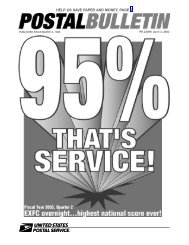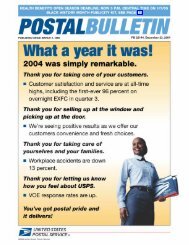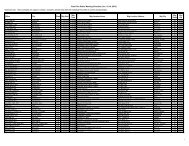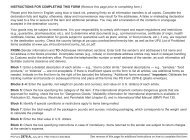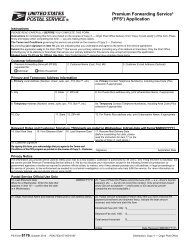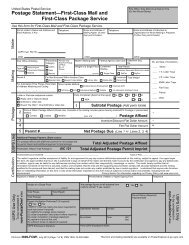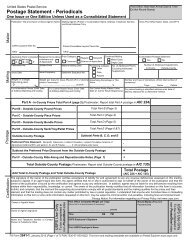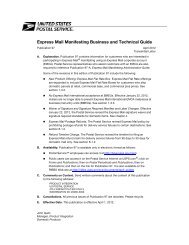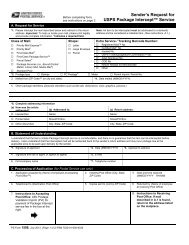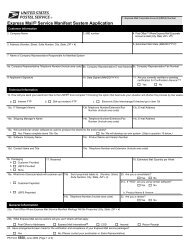2010 Comprehensive Statement on Postal Operations - USPS.com
2010 Comprehensive Statement on Postal Operations - USPS.com
2010 Comprehensive Statement on Postal Operations - USPS.com
You also want an ePaper? Increase the reach of your titles
YUMPU automatically turns print PDFs into web optimized ePapers that Google loves.
Chapter 2: Products and Services<br />
Product Development<br />
The <strong>Postal</strong> Act of 2006 divided postal products and services into two<br />
distinct categories — market dominant (also referred to as mailing<br />
services) and <strong>com</strong>petitive (also referred to as shipping services).<br />
Different rules for each category allow the <strong>Postal</strong> Service to bring<br />
new products and services to market more quickly, with greater<br />
pricing flexibility.<br />
Price changes <strong>on</strong> average for any class of mail within mailing<br />
services may not exceed the rate of inflati<strong>on</strong> based <strong>on</strong> the C<strong>on</strong>sumer<br />
Price Index (CPI) for the previous 12 m<strong>on</strong>ths. Price changes for<br />
shipping services must produce sufficient revenue above a price<br />
floor that covers attributable costs and, for shipping services as a<br />
whole, an appropriate share of instituti<strong>on</strong>al costs.<br />
Mailing Services<br />
Mailing services represent roughly 87 percent of all revenue. It<br />
includes First-Class Mail, Periodicals, Standard Mail, Package<br />
Services (single-piece Parcel Post, Bound Printed Matter, Media<br />
Mail, and Library Mail), single-piece Internati<strong>on</strong>al Mail, and Special<br />
Services and Ancillary Services such as Delivery C<strong>on</strong>firmati<strong>on</strong>,<br />
Certified Mail, and Post Office Box service.<br />
In October 2009, the <strong>Postal</strong> Service announced that it would not<br />
increase prices for mailing services during calendar year <str<strong>on</strong>g>2010</str<strong>on</strong>g> to<br />
promote stability and c<strong>on</strong>tinued use of mail in the face of severe<br />
ec<strong>on</strong>omic challenges affecting the mailing industry.<br />
FIRST-CLASS MAIL<br />
First-Class Mail is a “flagship” product for a range of applicati<strong>on</strong>s<br />
used by households and businesses. It may be used to send virtually<br />
anything up to 13 ounces that is eligible for mailing, such as cards,<br />
letters, large documents, or parcels. First-Class Mail is c<strong>on</strong>fidential<br />
and sealed against postal inspecti<strong>on</strong> except as authorized by law.<br />
Mail c<strong>on</strong>taining pers<strong>on</strong>al informati<strong>on</strong> — including all handwritten or<br />
typewritten material, bills, and statements — is required to be sent<br />
by First-Class Mail, Express Mail, or Priority Mail. Undeliverableas-addressed<br />
First-Class Mail is forwarded or returned to sender<br />
without additi<strong>on</strong>al charge. The service standards for First-Class Mail<br />
are 1 to 3 days in the 48 c<strong>on</strong>tiguous states, depending <strong>on</strong> distance<br />
and level of presort.<br />
First-Class Mail c<strong>on</strong>sists of six products with distinct prices<br />
and preparati<strong>on</strong> requirements that meet an array of retail and<br />
<strong>com</strong>mercial uses: single-piece letters/cards; presorted letters/cards;<br />
flats; parcels; internati<strong>on</strong>al outbound single-piece; and internati<strong>on</strong>al<br />
inbound single-piece. Single-piece (sometimes referred to as retail)<br />
requires no mailer sortati<strong>on</strong>; and presort (sometimes referred to as<br />
<strong>com</strong>mercial) requires mailer sortati<strong>on</strong>. Prices do not vary by distance.<br />
Single-piece is mostly used by households and small businesses for<br />
pers<strong>on</strong>al and business corresp<strong>on</strong>dence and transacti<strong>on</strong>s such as bill<br />
payments. No minimum number of pieces or sortati<strong>on</strong> is required.<br />
Prices vary by ounce and shape (card, letter, flat, or parcel).<br />
Presorted First-Class Mail is used mostly by medium and large<br />
businesses for statements, bills, and advertising. Presort prices are<br />
lower than single-piece prices because mailings must meet certain<br />
requirements including a minimum number of pieces, accurate<br />
addressing preparati<strong>on</strong>, and presorting by ZIP Code ranges to qualify<br />
for the lower prices. Prices vary by ounce, shape, and sortati<strong>on</strong><br />
level, and whether the pieces are prebarcoded and can be run <strong>on</strong><br />
automati<strong>on</strong> equipment and meet addressing standards.<br />
First-Class Mail revenue was $34.0 billi<strong>on</strong>, with a volume of<br />
78.2 billi<strong>on</strong> pieces. Revenue decreased 5.2 percent and volume fell<br />
6.6 percent. The overall volume decline, largely in the single-piece<br />
category, c<strong>on</strong>tinued a downward trend that started in 2002. Besides<br />
impacts from the recent ec<strong>on</strong>omic downturn, the decline can be<br />
attributed to c<strong>on</strong>tinued electr<strong>on</strong>ic diversi<strong>on</strong> of bills and statements,<br />
alternate payment methods, and fewer new applicati<strong>on</strong>s for<br />
this service.<br />
Even with volume declines and efforts to eliminate costs, the <strong>Postal</strong><br />
Service c<strong>on</strong>tinued to maintain excellent First-Class Mail service. Bills<br />
and statements represent about half the volume of presorted First-<br />
Class Mail, and al<strong>on</strong>g with the single-piece volume of remittances<br />
for those bills, make up nearly half of total First-Class Mail volume.<br />
The Phoenix-Hecht Surveys in January and July showed an overall<br />
improvement of nearly an hour (0.8 hour) for the year in handling<br />
remittance mail. Technology, transportati<strong>on</strong>, and processing<br />
improvements have reduced average processing times by more than<br />
8 hours since 1999. The Phoenix-Hecht Survey measures in hours<br />
the time that remittance mail travels from 170 originating cities to<br />
100 sites in 29 destinati<strong>on</strong> cities. Phoenix-Hecht is an independent<br />
research firm that has tracked remittance mail processing times for<br />
more than 10 years.<br />
The <strong>Postal</strong> Service works closely with customers to simplify and<br />
streamline the preparati<strong>on</strong> and barcoding of presorted mail. All<br />
sort levels for automati<strong>on</strong> letters are opti<strong>on</strong>al, giving mailers more<br />
flexibility and encouraging lower-volume mailers to design mail for<br />
automati<strong>on</strong> prices. A Full-Service Intelligent Mail barcode incentive of<br />
0.3 cent per piece for automati<strong>on</strong> letters and flats became available<br />
<strong>on</strong> November 29, 2009.<br />
For <strong>com</strong>mercial customers, the <strong>Postal</strong> Service ran a First-Class<br />
Mail Incentive program from October through December 2009.<br />
Eligible <strong>com</strong>panies were offered a 20 percent postage rebate for<br />
specific qualifying presorted volumes of letters, cards, and flats<br />
mailed during that period. A qualifying volume needed to exceed a<br />
mailer’s predetermined threshold. The short-term incentive program<br />
generated 212 milli<strong>on</strong> pieces and $75 milli<strong>on</strong> top-line revenue with a<br />
$19 milli<strong>on</strong> net c<strong>on</strong>tributi<strong>on</strong>.<br />
Thirty states and the District of Columbia allow “no excuse”<br />
absentee voting by mail. The <strong>Postal</strong> Service works with electi<strong>on</strong><br />
officials nati<strong>on</strong>wide to assist with their efforts to expand the adopti<strong>on</strong><br />
of voting by mail. Electi<strong>on</strong> Mail is promoted extensively through<br />
<str<strong>on</strong>g>2010</str<strong>on</strong>g> <str<strong>on</strong>g>Comprehensive</str<strong>on</strong>g> <str<strong>on</strong>g>Statement</str<strong>on</strong>g> <strong>on</strong> <strong>Postal</strong> Operati<strong>on</strong>s | 9



